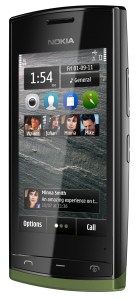
Although the company once promised it would switch to human-friendly names for phones, for years the company has tried to distinguish between different classes of phones by prepending them with letters: the E-series were mainly for business users, the X-series were all about portable media, the N-series were flagship high-end models, and the C-series (just over a year old) were for everybody else. Now, the company has announced it will be dropping letters from the names of its phones: phones will now be named with just numbers, starting today with the new Nokia 500.
According to Nokia, dropping the letters makes sense because the flexibility of modern mobile phones means people can use them for a variety of purposes, regardless of the niche for which they may have originally been intended. Business phones could be used for gaming, or entertainment phones might have wound up being key presentation tools. “The classifications were indicators, but often, they didn’t match-up [sic] to what people were actually doing with their phones,” Nokia wrote.
Nokia also thought the numbers contributed to user confusion across categories, as customers weren’t sure how (say) an N7 compared to an X7 compared to an E7. Were they essentially the same level of device, or totally different?
The new number system will be used to indicate a phone’s relative position on Nokia’s technology tree: phones with high numbers (e.g. 900) will be the top flagship phones, where a 100-series phone would be a more “accessible”—i.e. inexpensive—device.
Nokia’s first entry in its new numbering scheme makes no commitments either way. The Nokia 500 is built around the company’s Symbian Anna operating system, and sports a 1 GHz processor, 2 GB of storage (with up to 32 GB on removable microSD cards), Bluetooth, Wi-Fi, HSPA+ 3G connectivity, and battery life that should offer five to seven hours of talk time. Nokia says Symbian Anna offers an improved Web browser, split-screen messaging, and a refreshed user interface. The Nokia 500 will be available in black or white with user-swappable colored back covers; its suggested price will be around €150 before taxes and subsidies, and should launch in Europe in the third quarter.
Going with a numbers-only naming scheme for its phones is a risky move for Nokia, particularly given the large number of handsets the company produces at any one time. Nokia has already said it’s ditching its Ovi brand for mobile services (in favor or “Nokia Services”) and is in the midst of converting its entire phone line over to the WIndows Phone platform. That leaves precious few ways for Nokia to establish its own brand—something Apple has done with aplomb with its iPhone, and Samsung is managing to do with its Galaxy brand of smartphones and tablets. And HTC’s success with devices like the Sensation and Inspire may indicate consumers like to have a name they can associate with devices.
Editors' Recommendations
- Motorola is having a big sale on its foldable phones — from $500
- This flash sale gets you a refurbished iPhone from just $126
- How to remove location data from your iPhone photos
- The next iPhone SE may steal this feature from the iPhone 15
- How to remove someone else’s Apple ID from your iPhone


